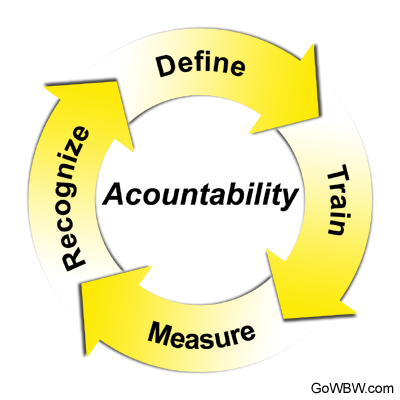There are many possible stumbling blocks to having a successful Near Miss Reporting System. Getting employees, supervisors, and management all to take part in a proactive reporting system is easier said than done. To learn more about why near misses do not get reported, see our article, "9 Reasons Near Misses Do Not Get Reported."
Methods to help resolve common near miss reporting issues will be discussed in this article.

The Four Step Cycle
Mike Williamsen Ph.D., a nationally recognized workplace safety consultant, and safety author Dr. Dan Petersen, collaborated over three years to develop a four step safety accountability system that helped a Fortune 20 company reduce their injury numbers by 80% within two years. This proven safety process has been very popular with companies for many years and it is an excellent way to empower all employees. The four steps are explained in detail below.
Step 1: Define and Communicate Expectations
Through training and ongoing conversations, it should be known by all employees what the expectations of the company are in regards to near miss reporting. For example, it may be expected that all employees are to report all unsafe conditions and near misses, no matter how minor the perceived risk may seem. Furthermore, the employees should be informed of what is expected of management throughout the reporting process. Management may be expected to communicate with the employee in a timely and positive manner with the results of his/her report.
Step 2: Training
Employees need to know the importance of, and the procedures of proper near miss reporting and that they are accountable for filing such reports correctly and timely. They need to know how the reporting system will work; the proper way to fill out the form; who they can report to; who can fill out the report with them; how recognition and/or incentive programs will work; and management's role.
Step 3: Measuring Performance
Near miss reports are not a sign of poor supervision. They are a means of reducing the risk of injury or property damage by activating proactive measures. By monitoring the information collected through a Near Miss Reporting System, troublesome areas can be tracked and corrected. The data will begin to show positive results as actual injuries and incidents begin to decline. Providing transparency will help ensure performance is accurately measured and disseminated to the entire workforce.
Step 4: Recognition and Incentives
Recognizing employees and providing incentive programs is a simple yet effective way to encourage near miss reporting. An effective incentive program will focus on rewarding employees for reporting hazards and taking an active role in creating a safer workplace. Simple incentives such as getting to leave work early, paid lunch, or parking privileges may work well to motivate employees. Avoid any incentive that may encourage near misses to go unreported.

Going Beyond The Four Step Cycle
Remove fear - If employees see coworkers being punished or reprimanded for getting injured or for reporting near misses, they will be less likely to report near misses themselves. There must be no blame placed for an injury and employees need to see appreciation and recognition for filing a near miss report. It must be clearly stated in all training materials that there will be no retribution for an injury or filing a near miss report.
Reports are important, not pointless - By stating the significance and importance of all employees participating in a Near Miss Reporting System, you are letting them know their involvement is not a waste of time or pointless, and that real results can be expected from everyone's involvement. In order to stay consistent with this emphasis on importance, all reported incidents, no matter how small or minor, must be treated with the same level of concern and importance.
Reduce peer pressure - Will a coworker's peers encourage him to file a near miss report, or will they discourage him and look at him as not very macho or manly, or brown-nosing management?
Management should consider the following to help eliminate peer pressure among coworkers:
-
Form employee teams to prioritize and evaluate near miss reports.
-
Circulate submitted near miss reports.
-
Publicize the corrections and improvements that result from reported near misses.
-
Provide the reporter with multiple personnel to submit a near miss report to.
Simplify the process - A complicated or unclear reporting process will make employees hesitant to report. Near miss reports must be fast and easy.
By empowering employees to recognizing and report near miss incidents, workplace safety can significantly improve, worker moral will increase, and the organization’s safety culture will be enhanced.
Want to Review the real reasons near Misses Go unreported. Watch the safety short video below:
Want to improve EHS processes with best practices and standards? Click Here to see the EHSSoftware.io EHS Software Suite.

